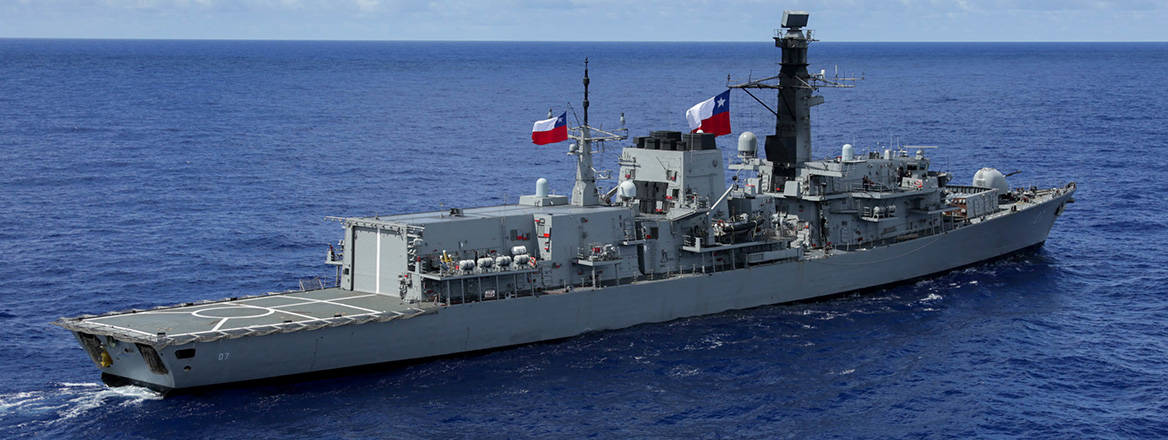Should Medium Naval Powers Like Chile Have Their Own Shipbuilding Capacity?
In South America, keeping costs and labour in local shipyards might be an option to compete with a heavily stressed global market.
A trend of increasing military build-up is pushing the world’s largest navies to reconsider their current strength. China today possesses the globe’s largest fighting fleet, and Western countries are making plans to catch up with Beijing, promising more resources to their shipbuilding industries. However, the geopolitics of naval yards brings challenges and opportunities for those seeking greater power projection.
There is sustained pressure in Western countries to efficiently and effectively address ship design, production and repair in a heavily competitive market. In Australia, the government decided to double the size of its surface fleet with 17 new ships by the mid-2040s, with at least eight built locally. In the US, it is expected that the number of fighting ships will increase to 390 in 2054, meaning that local shipyards would need to produce more vessels than they have over the past decade. Among middle powers, unrivalled supply chains and greater human capital are making a difference, such as in South Korea and Japan, which together account for 46% of the shipbuilding global market. So, what about ship construction in other geopolitically strategic countries with strong naval credentials?
Small and medium naval powers (those capable of combining coastal defence with an advanced fleet participating in global operations) such as Chile, Malaysia and South Africa are aiming to translate their moderate economic and naval strength into improved conditions for their navies, with increased interest in embracing modernisation and forging strategic alliances with the global defence industry.
In January, Chile’s President Gabriel Boric signed the Continuous National Shipbuilding Policy at the ASMAR Talcahuano plant, bringing what until recently was sector-based policy to what it implies will be a whole-of-government approach to naval construction. That said, the policy’s delivery depends on Boric’s ongoing fiscal austerity programme, increasing the risk that it may lose importance under a new government (Chile will hold presidential elections in late 2025), which might put a pause on this type of spending.
Small and medium naval powers like Chile are showing an increased interest in embracing modernisation and forging strategic alliances with the global defence industry
Policy papers on Antarctic and defence policy have become relevant for Chile since South America has gained greater geopolitical relevance, while others were released at a bad time, such as former President Michelle Bachelet’s oceanic policy, which – while very good – was published on the last day of her government, and did not receive the expected support from her successor Sebastián Piñera. Nothing can guarantee the success of Boric’s shipbuilding policy, but there is something in its favour: the Chilean Navy needs ships for the purposes of combat, logistical support and maritime services, and this policy seeks to ensure that core naval needs are met in national shipyards.
Chile’s current naval capabilities, the most modern in South America, include eight frigates, four submarines, two fleet oil tankers, four amphibious multipurpose ships, four maritime patrol ships of the offshore patrol vessel type and others of the tugboat type, plus icebreakers, oceanographic vessels, and patrol boats, among others – in addition to naval air resources and those needed by the Marine Corps.
ASMAR, the state-owned naval shipbuilding and repair yard, is currently focused on the construction of two amphibious multipurpose ships that are part of the Escotillón IV project, with two more under consideration but not yet authorised, which would replace the Aquiles, the Aldea and the two BATRAL-class barges currently in use, all at a cost of over a $1 billion.
This will keep ASMAR busy for at least five more years, and ASENAV – another local shipyard company – also has an important role in the development of the project, as well as multiple local suppliers. This means that approximately 50% of the production costs, and the consequent labour that this implies, will remain in Chile.
The Chilean navy plans to carry out the construction of eight frigates locally to replace the ones currently in use. Each new frigate is initially estimated to cost at least $400 million, a figure that would have to be reviewed to see what it entails. So far, there is political support, and local naval yards have experience in building smaller patrol vessels, such as the Piloto Pardo class.
The cost of new combat units will push the authorities to compare prices with used units in good condition. But the bigger question is whether ASMAR and ASENAV have the economies of scale that could allow them to obtain more reasonable costs and not take risks in construction. If the Chilean navy were to look for second-hand ships in good condition, they would not find them. The existing global geopolitical situation means that there are no quality offers available, unlike at the beginning of the 21st century. Navies in developed countries are extending the useful lives of their ships to give their shipyards time to produce what they need in the short and medium term.
Making a Business Case
International companies have taken notice of the growing South American market, with companies like Babcock, Naval Group, Thales, Navantia, Saab, ThyssenKrupp Marine Systems, BAE Systems, Aselsan and Indra exhibiting their shipbuilding and technological services at ExpoNaval, the region’s main maritime show, held biennially in Valparaiso.
Chile makes a powerful business case that justifies having a well-equipped navy with good ships. It is a country with an extensive Exclusive Economic Zone, has tricontinental interests, and depends on its foreign trade for its survival. This puts pressure on the navy, which must ensure that trade happens in an orderly and safe manner. Most recently, for example, the Strait of Magellan has become a hotspot for global shipping, and protecting this vital sea lane is ‘getting new attention from governments, multinational companies and others’ as geostrategic challengers, such as China and Russia, have increased their presence in the waters where the southern Pacific meets the Atlantic, and the Panama Canal is not performing at its best because of climate change.
The Strait of Magellan has become a hotspot for global shipping, and protecting this vital sea lane is receiving fresh attention as geostrategic challengers increase their presence in the region
This is understood by sailors and experts on the subject, but not necessarily by the politicians who must decide on the matter of the navy’s capabilities. The right-wing parties approach the issue from an economistic point of view – that is, ships are bought or built where it is most cost-efficient. The left and centre-left do not pay so much attention to this, they are keen on local industrialisation and what generates labour – even better if it happens in the southern Bio-Bio region, where ASMAR and ASENAV have their largest shipyards, which to some extent leaves the fate of construction policy in the hands of the executive and the political forces in Congress.
The navy is more pragmatic: it needs ships because without ships it is not a navy. If they are built locally, this is good, and if they come from abroad, this is also good, although there is an inclination for them to be built locally because this helps local shipyards to maintain their capacities in terms of repairs, modernisation and maintenance.
An example of the above was the acquisition in 2020 of two used Adelaide-class frigates from Australia, which were in very good condition, while in parallel, the Almirante Viel – a world-class 10,000-ton icebreaker – was being built locally. The latter reflects what Chile is capable of doing locally.
For now, efforts are being focused on four 8,000-ton amphibious multipurpose ships, but an interesting discussion is coming up about the renovation of Squadron ships and the submarine force, something that could cost between $5–8 billion, spread over several years. The Chilean Navy has received Babcock’s Arrowhead 140 frigate design, but the fierce competition for a contract may only start in 2026. Navies are not cheap, and their equipment is always a matter of analysis, so Chileans should get ready for the discussion to come.
© Richard Kouyoumdjian Inglis, 2025, published by RUSI with permission of the author
The views expressed in this Commentary are the author’s, and do not represent those of RUSI or any other institution.
For terms of use, see Website Ts&Cs of Use.
Have an idea for a Commentary you’d like to write for us? Send a short pitch to commentaries@rusi.org and we’ll get back to you if it fits into our research interests. Full guidelines for contributors can be found here.
WRITTEN BY
Richard Kouyoumdjian Inglis
RUSI Senior Associate Fellow, International Security
- Jim McLeanMedia Relations Manager+44 (0)7917 373 069JimMc@rusi.org



